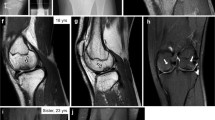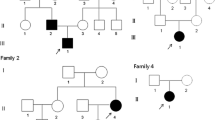Abstract
Familial articular chondrocalcinosis (CC) was first reported in 1963. It is characterised by multiple calcifications of hyaline and fibrous cartilage in the joints and intervertebral discs. Mutations in ANKH have been identified in several pedigrees as a monogenic cause for this disorder. ANKH is a key protein in pyrophosphate metabolism and is involved in pyrophosphate transport across the cell membrane. The objective of this work was to screen ANKH and ENPP1, two key genes in pyrophosphate metabolism, in Slovakian kindreds with familial CC. DNA samples from 25 individuals (10 affected, 15 unaffected) from 8 families were obtained. The promoter, coding regions and intron–exon boundaries of ANKH and ENPP1 were sequenced. Twelve DNA sequence variants, six in each gene, were identified. All the variants had been previously identified. None segregated with the disease. Our results suggest that neither ANKH nor ENPP1 mutations are the cause of CC in these families, indicating that possibly other major genes are involved in the aethiopathogenesis of this condition in these families.

Similar content being viewed by others
References
Zitnan D, Sitaj S (1963) Chondrocalcinosis articularis. Ann Rheum Dis 22:142–152
Baldwin CT et al (1995) Linkage of early-onset osteoarthritis and chondrocalcinosis to human chromosome 8q. Am J Hum Genet 56:692–697
Hughes AE et al (1995) Localisation of a gene for chondrocalcinosis to chromosome 5p. Hum Mol Genet 4(7):1225–1228
Andrew LJ et al (1999) Refinement of the chromosome 5p locus for familial calcium pyrophosphate dihydrate deposition disease. Am J Hum Genet 64:136–145
Ho AM, Johnson MD, Kingsley DM (2000) Role of the mouse ank gene in control of tissue calcification and arthritis. Science 289(5477):265–270
Timms AE et al (2002) Genetic studies of disorders of calcium crystal deposition. Rheumatology 41(7):725–729
Williams CJ et al (2002) Autosomal dominant familial calcium pyrophosphate dihydrate deposition disease is caused by mutation in the transmembrane protein ANKH. Am J Hum Genet 71:985–991
Pendleton A et al (2002) Mutations in ANKH cause chondrocalcinosis. Am J Hum Genet 71:933–940
Williams CJ et al (2003) Mutations in the amino terminus of ANKH in two US families with calcium pyrophosphate dihydrate crystal deposition disease. Arthritis Rheum 48(9):2627–2631
Gurley KA, Reimer RJ, Kingsley DM (2006) Biochemical and genetic analysis of ANK in arthritis and bone disease. Am J Hum Genet 79:1017–1029
Gurley KA et al (2006) Mineral formation in joints caused by complete or joint-specific loss of ANK function. J Bone Miner Res 21(8):1238–1247
Nakamura I et al (1999) Association of the human NPPS gene with ossification of the posterior longitudinal ligament of the spine (OPLL). Hum Genet 104:492–497
Rutsch F et al (2003) Mutations in ENPP1 are associated with “idiopathic” infatile arterial calcification. Nat Genet 34(4):379–381
Okawa A et al (1998) Mutation in Npps in a mouse model of ossification of the posterior longitudinal ligament of the spine. Nat Genet 19:271–273
Zhang Y et al. (2006) Investigation of the role of ENPP1 and TNAP genes in chondrocalcinosis. Rheumatology. doi:10.1093/rheumatology/kel338
Babij P et al. (2009) New variants in Enpp1 and Ptpn6 genes cause low bone density, crystal-related arthropathy and vascular calcification. J Bone Miner Res
O’Connell JR, Weeks DE (1998) PedCheck: a program for identification of genotype incompatibilities in linkage analysis. Am J Hum Genet 63(1):259–266
Laird NM, Horvath S, Xu X (2000) Implementing a unified approach to family-based tests of association. Genet Epidemiol 19(Suppl 1):S36–S42
Van der Korst JK, Gerards J, Driessens FM (1974) A hereditary type of idiopathic articular chondrocalcinosis. Survey of a pedigree. Am J Med 56(3):307–314
Gaucher A et al (1977) Hereditary diffuse articular chondrocalcinosis. Dominant manifestation without close linkage with the HLA system in a large pedigree. Scand J Rheumatol 6(4):217–221
Gaudreau A et al (1981) Familial articular chondrocalcinosis in Quebec. Arthritis Rheum 24(4):611–615
Reginato A, Zmijewski CM, Dalinka MK (1982) Calcium pyrophosphate dihydrate deposition disease (CPDD) in an Italo-north American. Arthritis Rheum 25:S76
Balsa A et al (1990) Familial articular chondrocalcinosis in Spain. Ann Rheum Dis 49(7):531–535
Reginato AJ et al (1975) Familial chondrocalcinosis in the Chiloe Islands, Chile. Ann Rheum Dis 34(3):260–268
Reichenberger E et al (2001) Autosomal dominant craniometaphyseal dysplasia is caused by mutations in the transmembrane protein ANK. Am J Hum Genet 68:1321–1326
Nurnberg P et al (2001) Heterozygous mutations in ANKH, the human ortholog of the mouse progressive ankylosis gene, result in craniometaphyseal dysplasia. Nat Genet 28:37–41
Zhang Y et al (2005) Association of sporadic chondrocalcinosis with a—4 basepair G-to-A transition in the 5′ untranslated region of ANKH that promotes enhanced expression of ANKH protein and excess generation of extracellular inorganic pyrophosphate. Arthritis Rheum 52:1110–1117
Spielman RS, McGinnis RE, Ewens WJ (1993) Transmission test for linkage disequilibrium: the insulin gene region and insulin-dependent diabetes mellitus (IDDM). Am J Hum Genet 52(3):506–516
Tsui FW et al (2003) Novel genetic markers in the 5′-flanking region of ANKH are associated with ankylosing spondylitis. Arthritis Rheum 48(3):791–797
Timms AE et al (2003) Investigation of the role of ANKH in ankylosing spondylitis. Arthritis Rheum 48(10):2898–2902
Allamand V et al (2006) A single homozygous point mutation in a 3′ untranslated region motif of selenoprotein N mRNA causes SEPN1-related myopathy. EMBO Rep 7(4):450–454
Reamon-Buettner SM, Cho SH, Borlak J (2007) Mutations in the 3’-untranslated region of GATA4 as molecular hotspots for congenital heart disease (CHD). BMC Med Genet 8:38
Ustek D et al (2008) MEFV gene 3’-UTR Alu repeat polymorphisms in patients with familial Mediterranean fever. Clin Exp Rheumatol 26(4 Suppl 50):S72–S76
Meyre D et al (2005) Variants of ENPP1 are associated with childhood and adult obesity and increase the risk of glucose intolerance and type 2 diabetes. Nat Genet 37(8):863–867
Frittitta L et al (2001) The Q121 PC-1 variant and obesity have additive and independent effects in causing insulin resistance. J Clin Endocrinol Metab 86(12):5888–5891
Hamaguchi K et al (2004) The PC-1 Q121 allele is exceptionally prevalent in the Dominican Republic and is associated with type 2 diabetes. J Clin Endocrinol Metab 89(3):1359–1364
Suk EK et al (2005) Association of ENPP1 gene polymorphisms with hand osteoarthritis in a Chuvasha population. Arthritis Res Ther 7(5):R1082–R1090
Acknowledgments
The authors would like to thank the National Institute of Rheumatic Diseases, Piestany, Slovakia, for making available the blood samples of the investigated pedigrees. MAB was funded by a National Health and Medical Research Foundation (Australia) Principal Research Fellowship.
Author information
Authors and Affiliations
Corresponding author
Rights and permissions
About this article
Cite this article
Couto, A.R., Zhang, Y., Timms, A. et al. Investigating ANKH and ENPP1 in Slovakian families with chondrocalcinosis. Rheumatol Int 32, 2745–2751 (2012). https://doi.org/10.1007/s00296-011-2022-8
Received:
Accepted:
Published:
Issue Date:
DOI: https://doi.org/10.1007/s00296-011-2022-8




